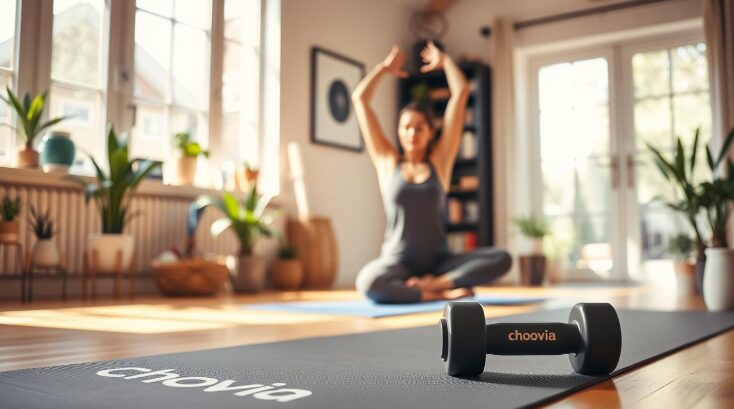Starting your fitness journey from home? You’re in the right place. In this guide to home workouts for beginners will show you how to get fit without needing a gym.
Whether you’re looking to lose weight, build strength, or simply stay active, these simple and effective at-home workouts are perfect for all fitness levels. No fancy equipment needed, just motivation and a little space.
Let’s dive into the best tips, routines, and exercises to help you get started and stay consistent.
Beginner's Guide to Home Workouts: Your Step-by-Step Start

Why Home Workouts Are Perfect for Beginners
Starting a fitness journey can feel overwhelming, but it doesn’t have to be. Besides, Home workouts are one of the best ways for beginners to ease into exercise without pressure or intimidation.
✔. No Gym Required
One of the biggest advantages of home workouts is accessibility. You don’t need a gym membership or expensive equipment to get started. Furthermore, With just your bodyweight and a small space, you can begin building strength, flexibility, and endurance right from your living room.
✔. Go at Your Own Pace
Home workouts allow you to set your own pace. There’s no competition or comparison—just you and your goals. This makes it easier to stay consistent, build confidence, and avoid injury.
✔. Save Time and Money
Skip the commute and costly gym fees. Home workouts fit into any schedule, whether you have 10 minutes or a full hour. For beginners, this flexibility is key to developing a long-term habit.
✔. Comfortable Environment
Exercising at home removes the fear of judgment. You can wear what you want, take breaks when needed, and create a routine that works for you. This comfort helps you stay motivated and focused on progress.
✔. Endless Free Resources
From YouTube workouts to mobile fitness apps, there’s no shortage of free beginner-friendly guides available online. You can explore different styles, like yoga, HIIT, or bodyweight training, until you find what you love.
How To Start Home Workouts with Zero Experience
1.Start Small and Keep It Simple
When you’re just beginning, it’s important not to overwhelm yourself with complex routines or long workout sessions.
In fact, Focus on simple bodyweight exercises like squats, push-ups (use a wall or knees for modification), lunges, and planks. These movements build foundational strength, improve mobility, and help you understand basic form.
Start with just 10 to 15 minutes per session. It’s enough to activate your muscles and begin creating a habit, without causing burnout or injury.
2. Set a Realistic Schedule Consistency beats intensity, especially in the beginning. Choose 3 to 4 days per week and schedule your workouts like any important appointment.
It could be early morning, during lunch, or in the evening, whatever fits your lifestyle best. Also, sticking to a routine helps build momentum and makes working out feel like a regular part of your day.
3. Create a Workout Space
You don’t need a big home gym to get results. All you need is a small area with enough room to move freely. Lay down a yoga mat or towel for comfort.
Try to keep this space tidy and free of distractions, it’ll make it easier to stay focused and motivated. Having a dedicated workout spot also signals your brain that it’s “go time.”
4. Use Free Resources
You don’t need to hire a personal trainer or buy an expensive app to get started. Platforms like YouTube offer thousands of free beginner-friendly home workout videos that guide you step-by-step.
There are also free apps that offer structured programs, progress tracking, and tips on proper form. These resources can help you stay motivated and give your workouts structure without any cost.
5. Listen to Your Body
At first, you might feel sore, and that’s perfectly normal. But there’s a difference between soreness and pain.
Always listen to your body and rest when needed. Focus on doing exercises correctly rather than quickly, and take short breaks when necessary.
Stay hydrated, warm up before starting, and don’t forget to cool down and stretch after each session. Recovery is just as important as the workout itself.
Simple 5 Home Workouts to Get YOU Going

When you’re just starting out or want to keep things straightforward, these five simple home workouts are perfect for beginners with unbelievable results. They don’t require any special equipment and can be done in the comfort of your home.
1. Bodyweight Squats
Bodyweight squats are excellent for building strength in your legs and glutes. Stand with your feet shoulder-width apart, lower your body by bending your knees, and push your hips back, as if you’re sitting into a chair.
Keep your chest lifted and your knees behind your toes. Aim for 2–3 sets of 12–15 repetitions to start. Squats target your quads, hamstrings, and glutes, helping to improve lower body strength and stability.
2.Push-Ups (Modified or Full)
Push-ups are a fantastic exercise for your chest, shoulders, and triceps. If full push-ups are too challenging at first, start with modified push-ups by performing them on your knees or against a wall.
Keep your core engaged and lower your chest towards the floor, then press back up. Begin with 2 sets of 8–10 repetitions, and gradually increase as your strength improves.
3. Planks
Planks are one of the best core-strengthening exercises. Start in a push-up position but with your weight resting on your forearms. Keep your body in a straight line from head to heels, engaging your core to avoid sagging.
Hold for 20-30 seconds, then rest. Work up to longer holds as you build strength. Planks are great for improving posture and strengthening the entire core.
4. Lunges
Lunges are an excellent lower body exercise that targets the legs and glutes. Stand with your feet together, step forward with one leg, and lower your hips until both knees are bent at about 90 degrees.
Push off the front foot to return to standing. Alternate legs and perform 2–3 sets of 10–12 repetitions per leg. Lunges help improve balance, flexibility, and coordination.
5. Glute Bridges
Glute bridges are perfect for activating the glutes and strengthening the lower back. Lie on your back with your knees bent and feet flat on the floor, hip-width apart.
Lift your hips towards the ceiling by pressing through your heels, squeezing your glutes at the top.
Hold for a second and slowly lower your hips back to the floor. Do 2–3 sets of 12–15 repetitions. This exercise helps strengthen your glutes, lower back, and core muscles.
These five exercises provide a solid full-body workout that’s easy to do at home with no equipment. Aim to perform these exercises 3–4 times a week to build strength, endurance, and flexibility over time. They are great for beginners and can be modified as you progress in your fitness journey.
Common Beginner Mistakes to Avoid in Home Workouts
Starting home workouts is a great way to improve your fitness, but beginners often make a few common mistakes that can hinder progress or lead to injury. Avoiding these mistakes will help you get the most out of your workouts and stay safe while training at home.
❌ Skipping Warm-Ups
Many beginners skip warming up, thinking it’s unnecessary. However, warming up is essential to prepare your muscles and joints for exercise, increase blood flow, and reduce the risk of injury.
According to a study published in National Library of Medicine, Warm-ups are shown to reduce injury risk, especially over time. They also help activate muscles and nervous system such that when you skip warm-ups, your body isn’t “primed” is more likely to underperform or risk injury.
A few minutes of light cardio (like jogging in place or jumping jacks) and dynamic stretches will help get your body ready for a more intense workout.
❌ Using Incorrect Form
One of the most important aspects of any workout is using proper form. Bad posture or incorrect technique during exercises can lead to muscle strain or injury.
If you’re unsure about the correct form, consider watching tutorial videos or using a mirror to check your technique. Focus on controlled movements and engage your core to protect your back.
❌ Overdoing It Early On
It’s tempting to push yourself too hard when you’re excited to start, but doing too much too soon can cause burnout or injury.
Begin with shorter, more manageable sessions and gradually increase the intensity or duration as your body adapts. Listen to your body and avoid pushing through pain or discomfort. Progress at a pace that feels sustainable for you.
❌ Not Cooling Down
Just as warming up is important, cooling down is also crucial for recovery. Skipping your cool-down can lead to muscle tightness and soreness the next day.
After your workout, spend 5–10 minutes stretching to help your muscles relax and improve flexibility. Focus on slow, controlled stretches, especially for the muscles you worked the most.
❌ Neglecting Rest and Recovery
Rest is often overlooked, but it’s just as important as the workout itself. Your body needs time to recover and repair muscles after exercise, so make sure to get enough sleep and take rest days between intense workouts.
Overworking without rest can lead to fatigue, decreased performance, and even injury. Balance your workouts with proper recovery to see the best results.
❌ Comparing Yourself to Others
In the age of social media, it’s easy to get caught up in comparing yourself to others. But fitness is a personal journey, and everyone progresses at their own pace.
Focus on your own improvement, set personal goals, and celebrate small victories. Progress is progress, no matter how slow it feels at times.
By avoiding these common mistakes, you’ll create a safer, more effective fitness routine and stay on track with your goals. Take things slow, focus on form, and make rest a priority as you build strength and endurance from home. Remember, consistency is key, and progress takes time.
Scaling Up Your Home Workout Routine
After about 4-6 weeks of regular workouts, your body will have adapted to the initial intensity, and you may notice your progress slowing down.
This is the ideal time to start scaling. Increasing the challenge helps to avoid plateaus, improve strength, and prevent your routine from becoming too easy.
Scaling up your home workout routine involves gradually increasing the intensity and variety of your exercises to challenge your body and continue making progress.
Start by adding more sets, repetitions, or time to your workouts, and incorporate more advanced exercises as your strength and endurance improve.
You can also use resistance bands, dumbbells, or kettlebells to add extra resistance and make the exercises more challenging.
Don’t forget to vary your workouts to target different muscle groups, prevent boredom, and avoid plateaus.
By gradually increasing the difficulty while focusing on proper form and recovery, you’ll keep your workouts effective and continue advancing toward your fitness goals.
General Tip: Stay consistent with your routine and aim for regular sessions each week. Focus on proper form to prevent injury and get the most out of each exercise.
Conclusion
In conclusion, starting and maintaining a home workout routine is an excellent way to improve your fitness, even with zero experience.
By beginning with simple exercises, setting realistic goals, and staying consistent, you can build strength, endurance, and confidence right at home. Remember to scale your routine as you progress and avoid common mistakes that can hinder your results.
With dedication, proper form, and a balanced approach, you can achieve your fitness goals and make home workouts an enjoyable and sustainable part of your lifestyle. Stay patient and committed—the results will follow!








did you find this helpful ??